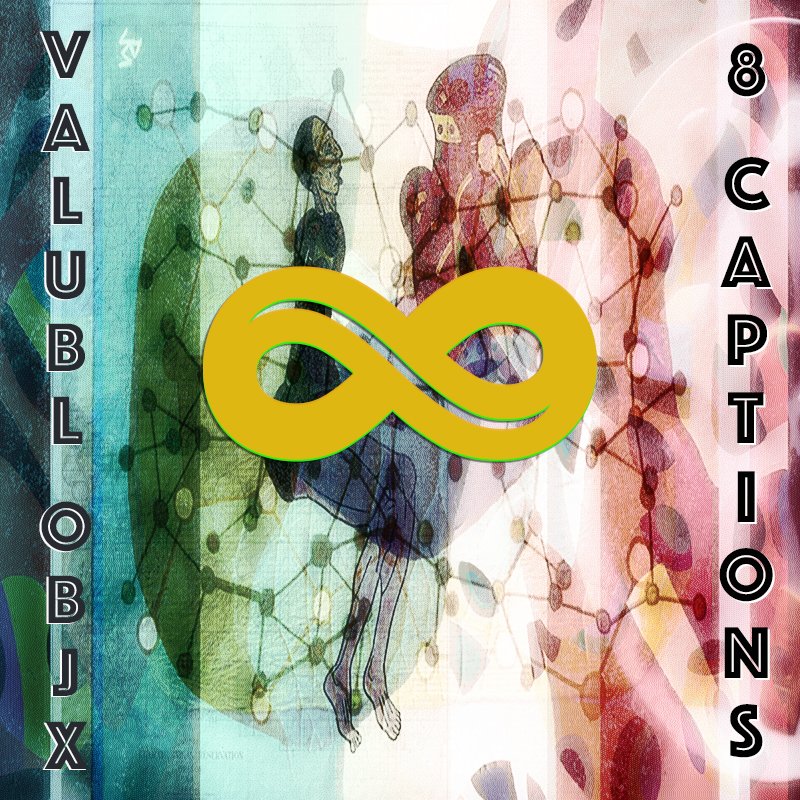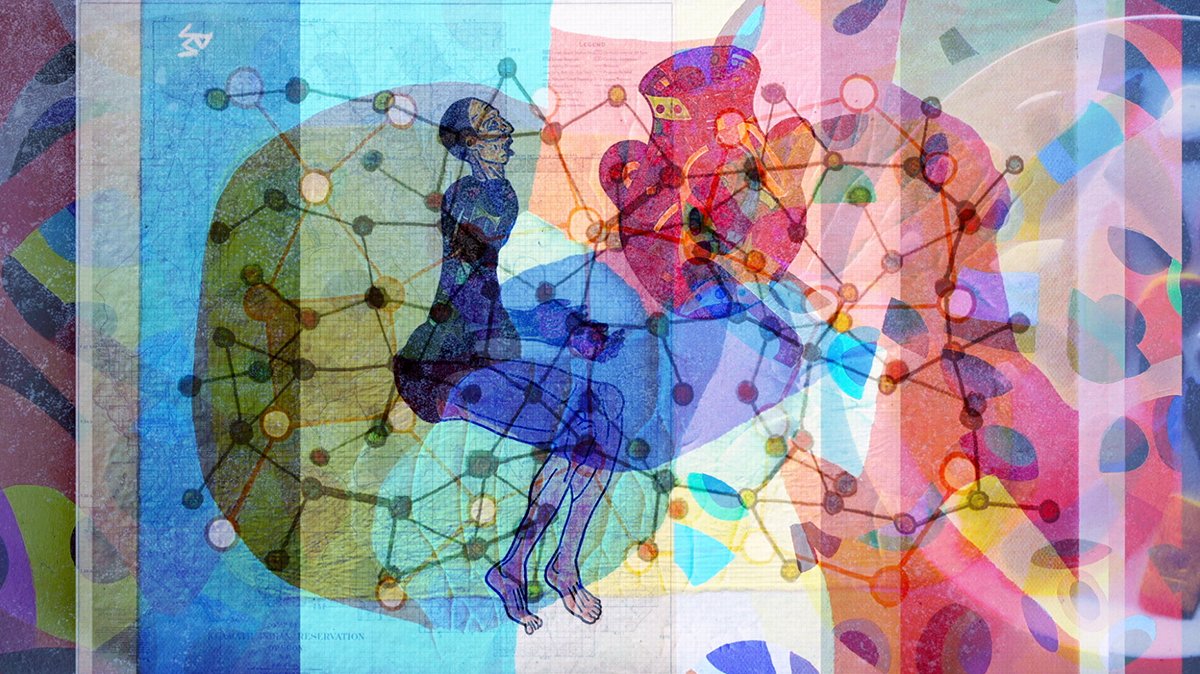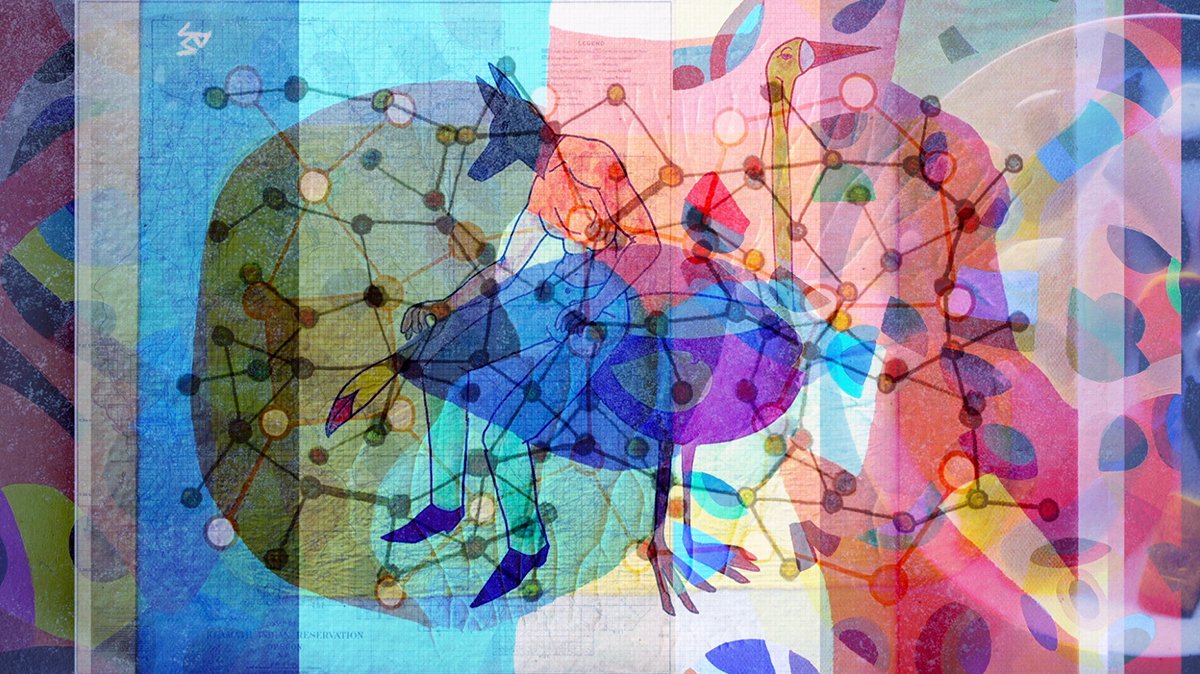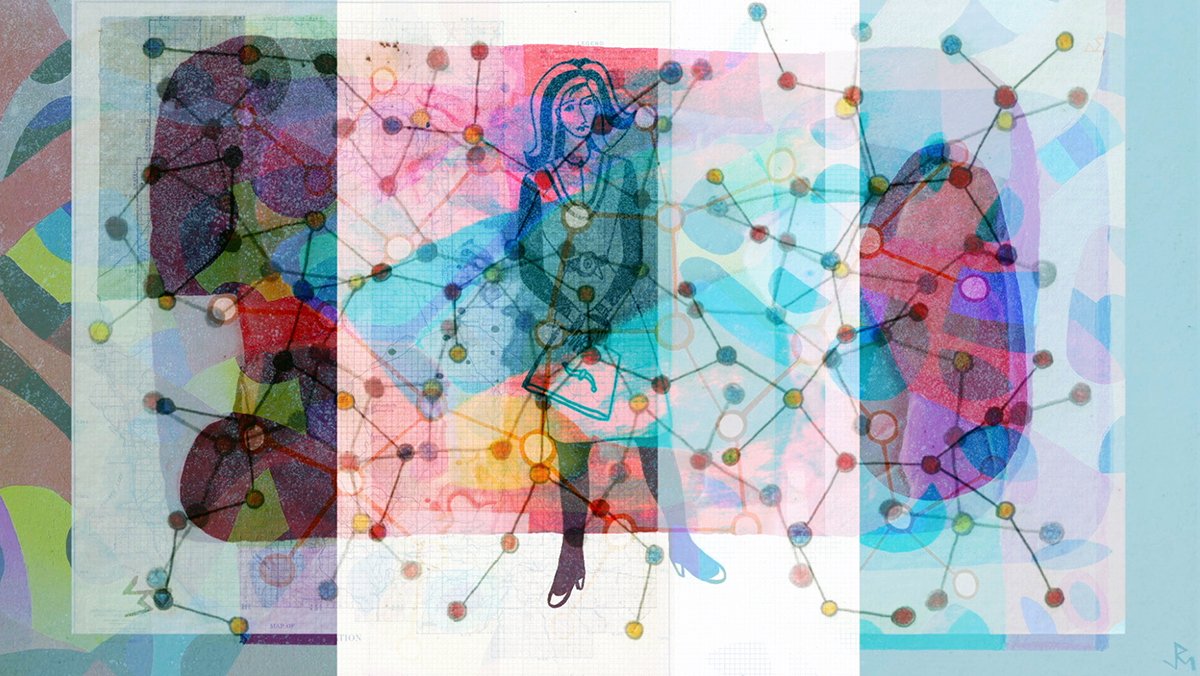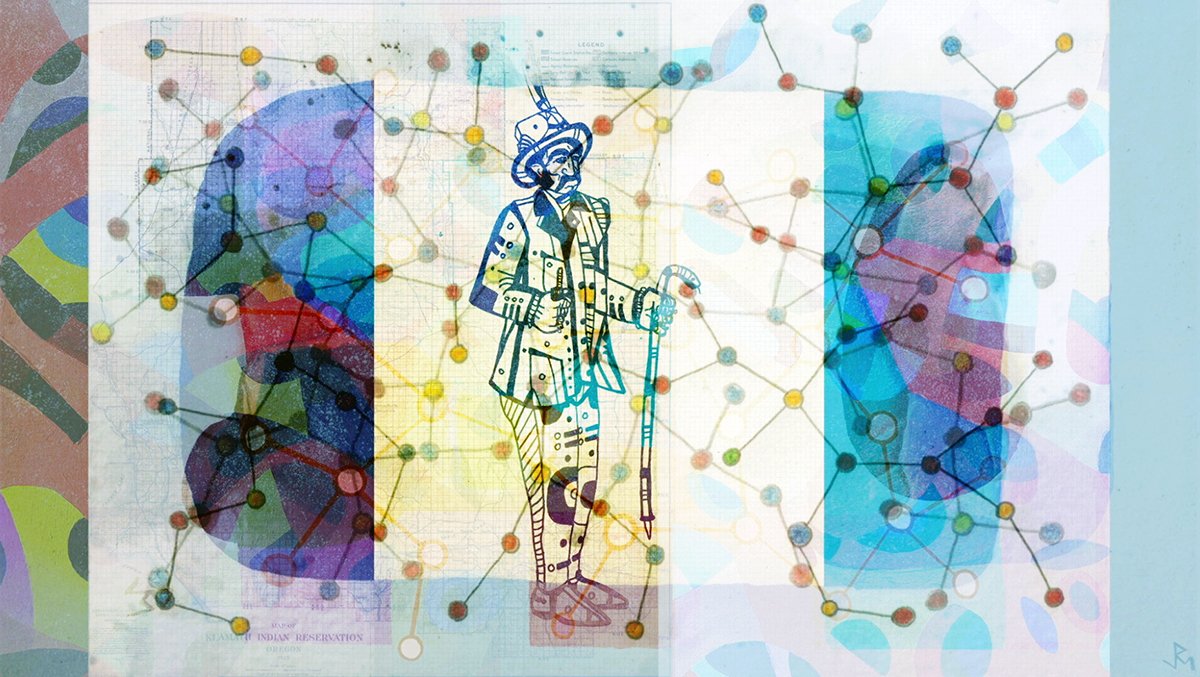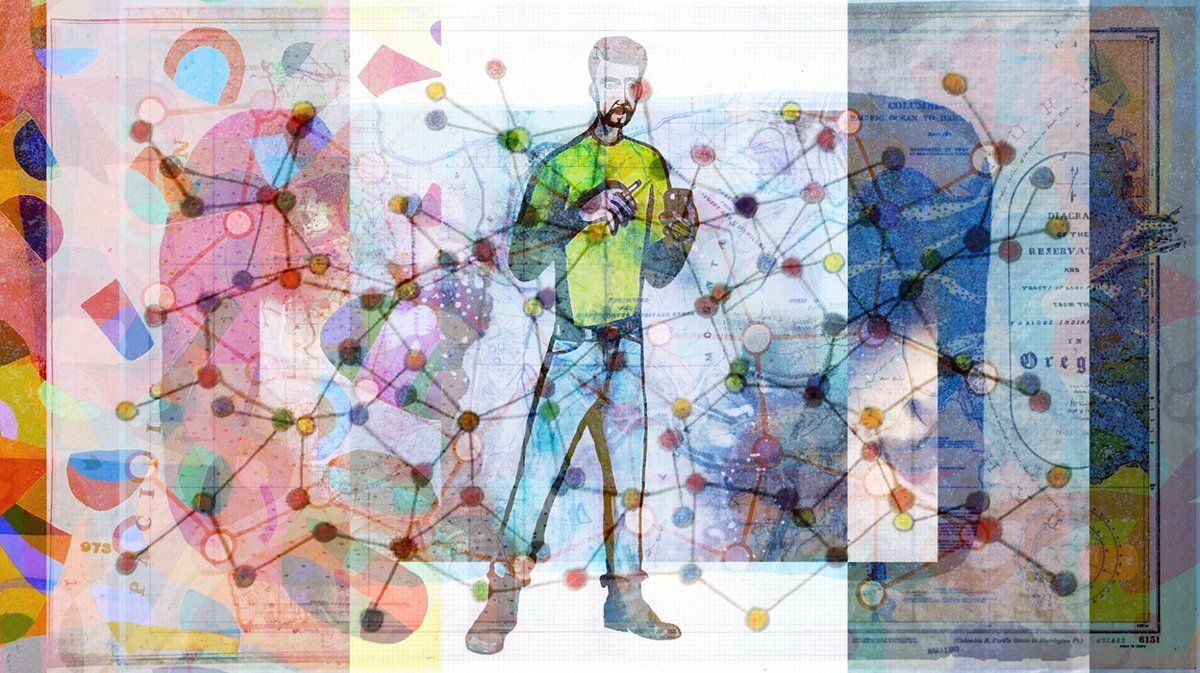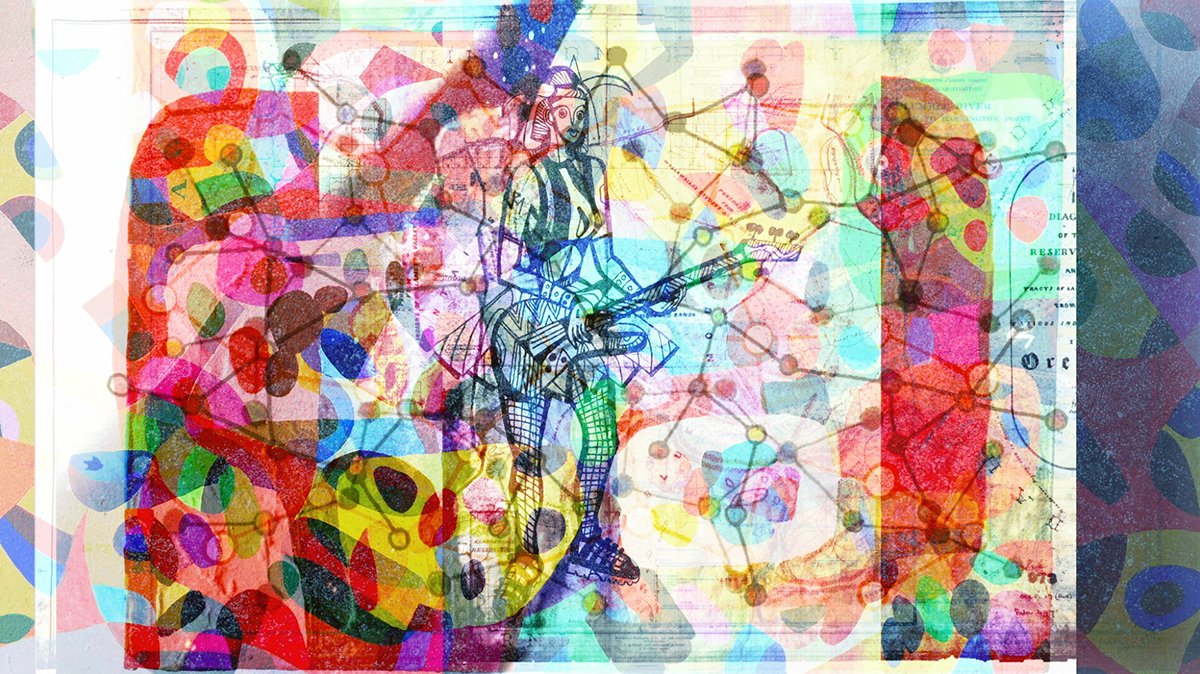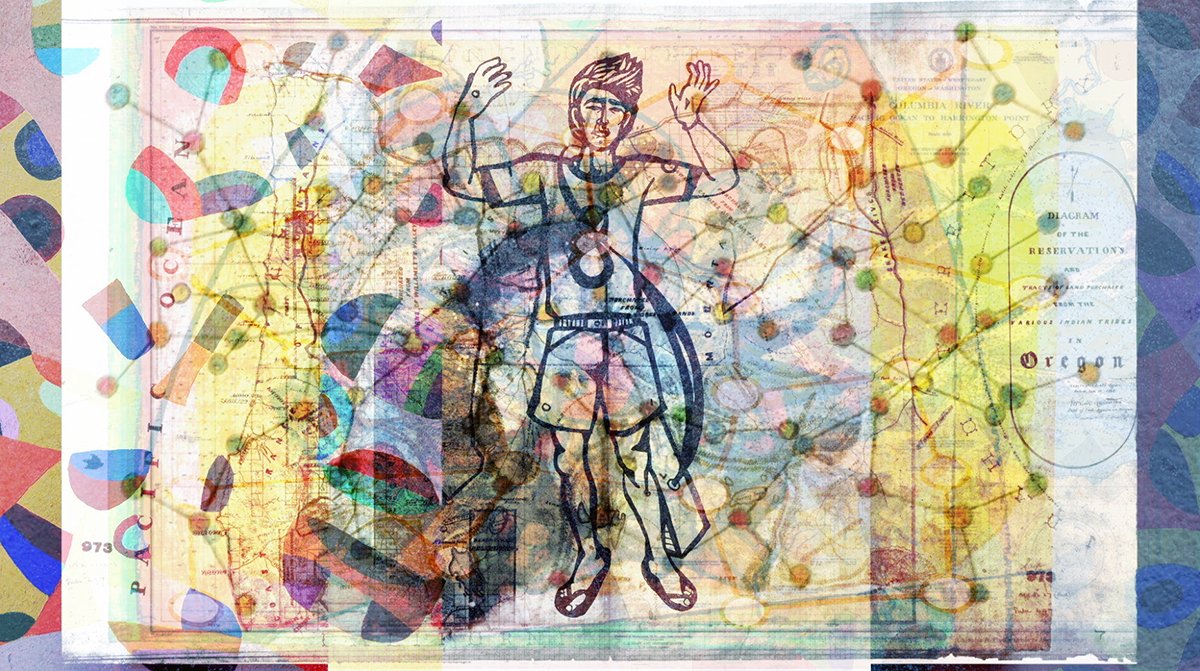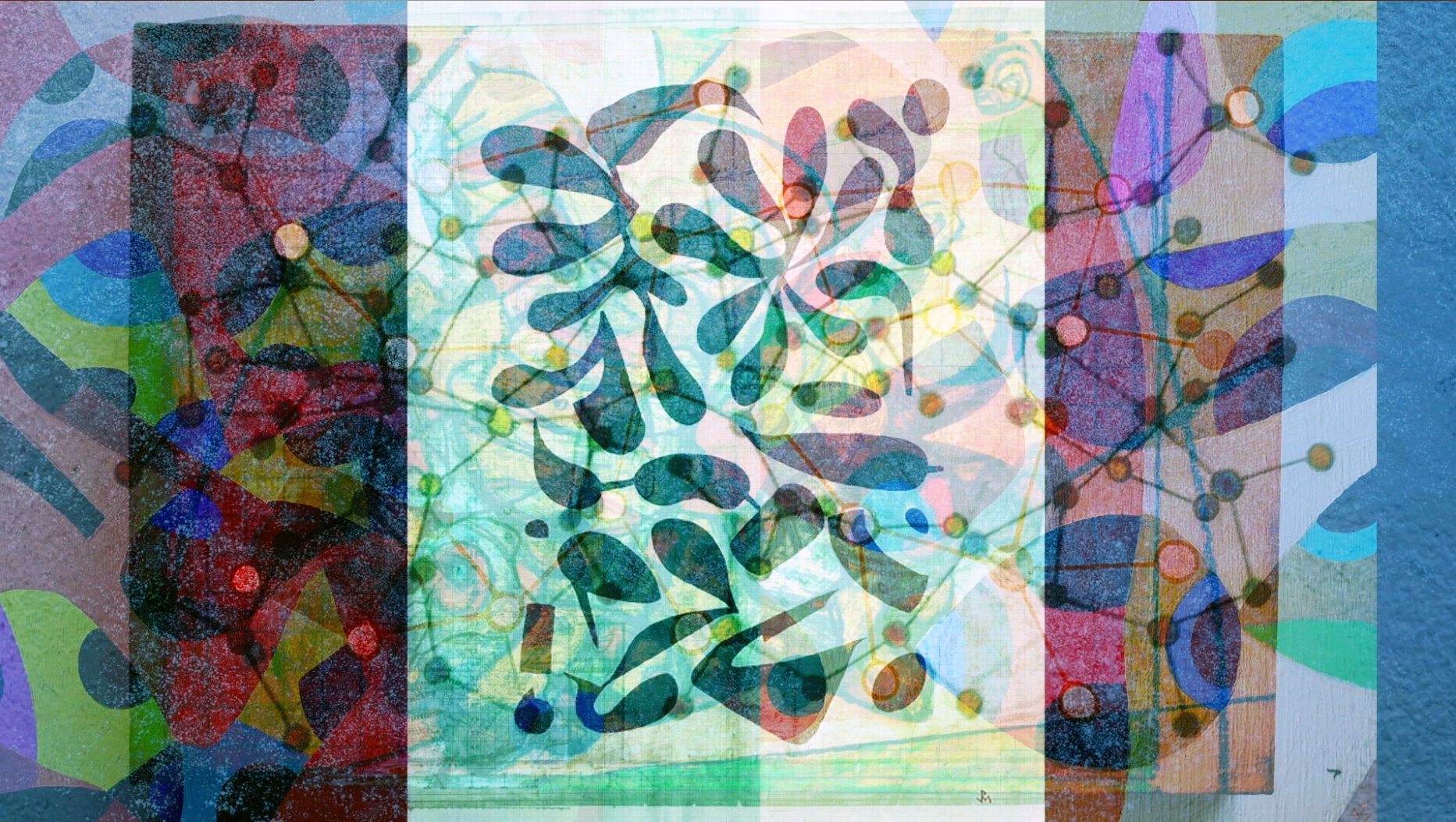VALUBL OBJX: Afterword [CODA]
8 Captions
By Paul McLean
PLATE 1
In the Post-Contemporary Period (PCP), everything is smeshed together. An image flashes across space and time to be eventful. In Plate 1 the embedded sketch contains a cauldron. The reference is The Book of Changes, or I Ching. The picture is an animation frame. In the frame, the stylized figure, mouth open, is forming a Canto. (RIP CG Jung, and Ezra Pound). A drawing of a person cannot produce sound. The cartoon is levitating the ceremonial pot. Did you notice the word “LEGEND” next to and above the container? A recessed (buried) map charts the territories of indigenous tribes in the American Pacific Northwest, where I now live and work. Layers of digital textures: details of my EVENT Series vinyl paintings; samples from the NODES Series of sketches and paintings on museum board; and copyright free stock images of ink on paper. What are the image’s prime points of interest, and how does the eye progress among the optical attractors? The sound is Off.
PLATE 2
In two texts, I chronicled my passage through Post-Show Mode (PSM) and Post-Post-Show Mode (PPSM) after the closing of my exhibit VALUBL OBJX at Made in Astoria gallery in Astoria, Oregon. In PSM/PPSM, the artist may transition from the activities of art production and presentation into a relatively inactive phase, one that may be permanent. I immediately drift into this mind-space when the art is removed from the gallery wall and returns to the home, studio or storage. Over a long artistic career, I have learned to avoid the trap of looking backward at what just happened, in the bravado-tinted guise of Wolf Man, or forward, like an odd befuddled prehistoric bird, wondering about what’s next. It is better I find to resign oneself to temporarily inhabiting hybrid, present-situated quasi-creative persona, a virtual self-aware replica. […Think of it as s-Artist Prime (or sAP)?] Recovery, recreation and cautious reflection are recommended. Reactive or reflexive impulses are not. Is it beneficial during PSM/PPSM to survey the dimensional context of one’s existence? In small, gentle doses, possibly.
PLATE 3
During PSM/PPSM I can’t avoid feeling inside-out, sensitive, vulnerable, especially if there are no reviews or little to no quality community discourse following the closure of an exhibit. This is doubly true in the absence of sales. Feedback need not be affirmative, as long as it is constructive. In the social media era continuity is added value. If one has little to post, after a busy publishing schedule, the platform algos recognize the drop in frequency, and move on, to emphasize more frenetic-paced accounts. For the user the interruption of virtual interaction can be jarring. The feeling is similar to waiting over-long at a bus stop or train station. Discomfort reveals the extent to which one has been trained to push content as a sign of life. One may crave followers’ like-clicks. It is not advisable to fill one’s streams with digital placebos, either. Take a break instead. Re-absorb the releasing compressed energies, as in digestion.
PLATE 4
PSM/PPSM can precipitate the artist’s confrontation with the ambient romanticism hovering over the creative lifestyle. One can be bedazzled by a positive reception for an exhibit. Embracing the role of the dandy in the show’s afterglow can be cathartic. Alternatively, one can sink into despair, loathing, and maudlin indulgence. Success and Failure are polar extremes that can dent the fragile identity with which most of us in the arts operate, when we are not bounding from pinnacle to pinnacle of inflated confidence, earned or not. It is helpful to have in place solid markers of value by which one can discern meaning in an artistic progression. Expressive realization does not fit linear analysis well. The process is dimensional, evolutionary. Being and becoming are art’s immaterial core. However viewers, peers, collectors, dealers, critics and casuals respond to the exhibition, the artist is anchored to things, and anchored by making them, in contradiction to Chaos and Chance.
PLATE 5
The skin is a costume in gaming, the vestment of a “meat puppet” in virtuality, where the player is alien, a migrant passing through the 01 ether. The phenomenal circumstances of the artist in PSM/PPSM resonate with the actual person temporarily inhabiting the foreign territories of VR. In the simulation, consequences accrue by design, within assigned parameters. Appearances and experiences are governed by physics and logics peculiar to the artificial environment. In the Real World, in Real Life, one discovers the nature of choice. Human reality is a wovenform function of decision-making. Fate is the medium for the NRP character, not us 1st-person agents. Keeping in mind that art is no game, but the two domains are mimetic in some facets, artists in the PCP must diverge from the programming presets that might be systematically superimposed upon them through media, platforms and social conventions arising from the forces driving politics, economics and culture in the historical moment. Our autonomy is a singular responsibility, to the degree possible within one’s set of givens. A profile is not destiny. Be a free radical. An anomaly, if it suits you.
PLATE 6
Stringing together alt.affirmations is fun: Be Punk. Be unconventional. Be unmanageable. Hashtag ‘em and post ‘em with selfies on the Gram. Another good exercise is generating dodgy truisms: For an artist, eccentricity is not a vice; Advising an imaginary creative collective is redundant, because we share a weird original, authentic mindset; The soundtrack of living is bio-instrumental, as easy as humming or whistling… PSM/PPSM is fertile ground for non-sequiturs, even nonsense. Out of the churn of one’s creative reorganization and redirection, the nonsensical should give way to the poetic (RIP John Berryman). Which is not to suggest one throw caution to the wind. Be a wary visionary. A useful tactic or technique for an artist in a state of reformation is buffering. Insulating oneself from righteous anger, fear mongering, addictive consumerism, and other ugly facts of PCP life, makes room for new viewpoints. One can turn the PSM/PPSM toward connecting data points, outside the miasma of push campaigns competing constantly for one’s attention. An artist can seek absorption elsewhere, including the wilderness, the archive, the journal. A book can be an asylum (e.g., Cormac McCarthy’s final duo of novels), for the aesthete aficionado of the hyperreal.
PLATE 7
Whatever you do, don’t give up. Being in the void does not necessarily entail becoming the void itself. One in zero is not a death sentence. It is a clue about representation. It is also a warning about the determinate power of narrative. An artist in PSM/PPSM ought to refrain from composing fictional accounts of the past or future. Hesitancy in adopting existential subtexts to explain things is encouraged. I have found that the conception of trustworthy alternate personas for these intermediate situations and scenarios is hugely helpful. I find that navigating the intermissions in art life can take on its own expressive form. Cultivating formulae for surviving the inevitable creative troughs one goes through over years and decades of dedicated artistic practice is nigh essential. The trick is perspective. Keen perception requires rigor, especially once one leaves youth behind, and time does its number on each of us, more or less. What one must never forget is that art is a gift, whatever its price. Like life, to make of what we will, while there is yet any freedom at all.
PLATE 8
The artist mind has been long associated with lunacy. If one happens to be an artist who shows with frequency, enough to be a cyclic exhibitor, the PSM/PPSM could be likened astronomically to a waning moon, followed by an emptied sky. An experienced sky watcher has confidence that the lunar decline phase will pass, and the waxing and full moon will reappear in due course. For some of us, though, PSM/PPSM is like an annular eclipse, such as the one that will occur Saturday, October 14, visible across much of the USA. The heavens grow dark. We are witness to a celestial phenomenon, an event, a natural weirdness, not unheard of, but not normal either. The heavenly stuff that colors superstition, myth and legend. Art rarely if ever attains the gravity, intensity or longevity of those culturally significant undercurrents (superstition, myth, legend). But an artist can dream, yes? And it is not crazy to, when the waking world is a-swirl in the myriad of madness.
Thursday, October 12, 2023, 10:15PM (PST)
Astoria, OR

